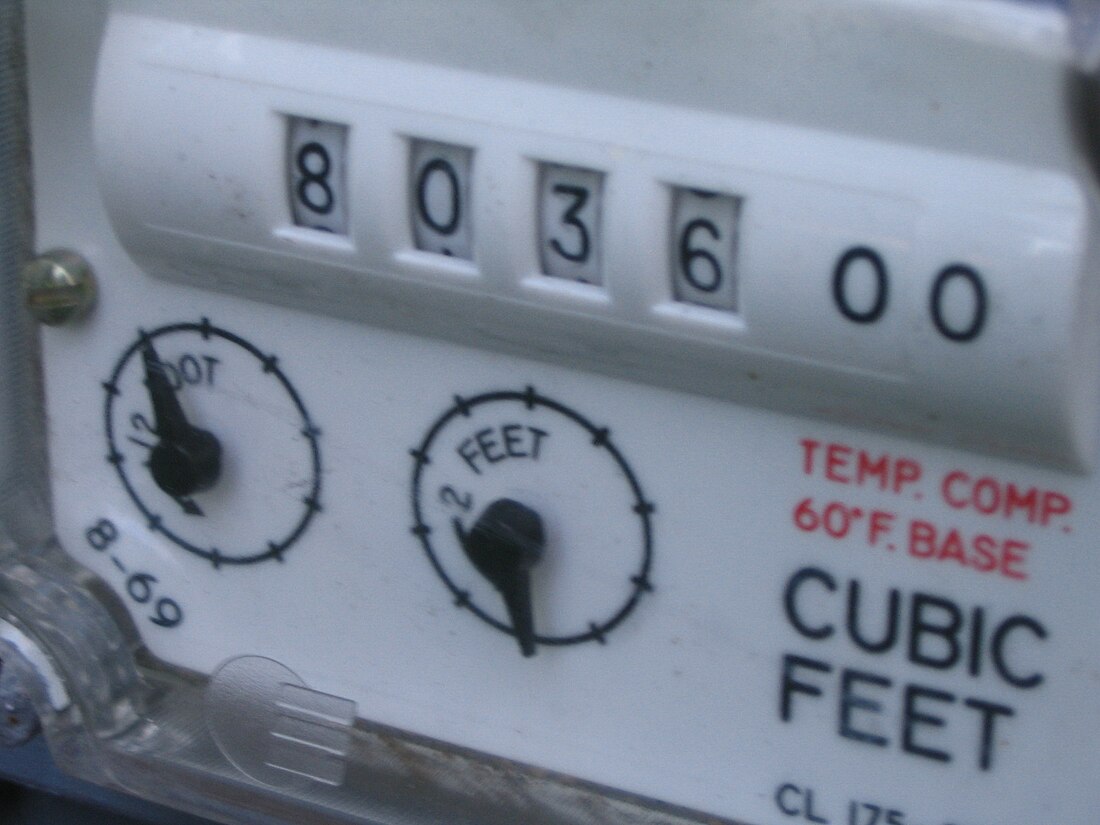The cubic foot (symbol ft3 or cu ft)[1] is an imperial and US customary (non-metric) unit of volume, used in the United States and the United Kingdom. It is defined as the volume of a cube with sides of one foot (0.3048 m) in length. Its volume is 28.3168 L (about 1⁄35 of a cubic metre).
| cubic foot | |
|---|---|
 Gas meter with volume measured in cubic feet | |
| General information | |
| Unit system | Imperial and US Customary |
| Unit of | Volume |
| Symbol | ft3, cu ft |
| Conversions | |
| 1 ft3 in ... | ... is equal to ... |
| US Customary | 1728 in3 1⁄27 yd3 |
| SI units | 0.02831685 m3 |
Conversions
This section needs additional citations for verification. (December 2019) |
| 1 cubic foot | = 1728 cubic inches | |
| = 1⁄27 of a cubic yard | ||
| ≈ 0.037037 yd3 | ||
| = 0.028316846592 m3 | ||
| = 28.316846592 L | ||
| = 576⁄77 US fluid gallons | ||
| ≈ 7.4805 US fl gal | ||
| = 73728⁄77 US fluid ounces | ||
| ≈ 957.5065 US fl oz | ||
| ≈ 6.2288 imperial gallons | ||
| ≈ 996.61 imperial fluid ounces | ||
| ≈ 0.80356 US bushels | ||
| ≈ 0.17811 oil barrel | ||
Symbols and abbreviations
The IEEE symbol for the cubic foot is ft3.[1] The following abbreviations are used: cubic feet, cubic foot, cubic ft, cu feet, cu foot, cu ft, cu.ft, cuft, cb ft, cb.ft, cbft, cbf, feet3, foot3, ft3, feet/-3, foot/-3, ft/-3.[citation needed]
Larger multiples are in common usage in commerce and industry in the United States:
- CCF or HCF: Centum (Latin hundred) cubic feet; i.e., 100 ft3
- Used in the billing of natural gas and water delivered to households.
- MCF: Mille (Latin thousand) cubic feet; i.e., 1000 ft3
- MMCF: Mille mille cubic feet; i.e., 1000000 ft3
- MMCFD: MMCF per day; i.e., 1000000 ft3/d
- Used in the oil and gas industry.
- BCF or TMC: Billion or thousand million cubic feet; i.e., 1000000000 ft3
- TMC is usually used for referring to storage capacity and actual storage volume of storage dams.
- TCF: Trillion cubic feet; i.e., 1000000000000 ft3
- Used in the oil and gas industry.
Cubic foot per second and related flow rates
The IEEE symbol for the cubic foot per second is ft3/s.[1] The following other abbreviations are also sometimes used:
- ft3/sec
- cu ft/s
- cfs or CFS
- cusec
- second-feet
The flow or discharge of rivers, i.e., the volume of water passing a location per unit of time, is commonly expressed in units of cubic feet per second or cubic metres per second.
Cusec is a unit of flow rate,[2] used mostly in the United States in the context of water flow, particularly of rivers and canals.
Conversions: 1 ft3s−1 = 0.0283168 m3/s = 28.3168 L/s = 1.699011 m3/min = 1,699.011 L/min
Cubic foot per minute
The IEEE symbol for the cubic foot per minute is ft3/min.[1] The following abbreviations are used:
- cu ft/min
- cufm
- cfm or CFM
- cfpm or CFPM
Cubic feet per minute is used to measure the amount of air that is being delivered, and is a common metric used for carburetors,[3] pneumatic tools, and air-compressor systems.[4]
Standard cubic foot
A standard cubic foot (abbreviated scf) is a measure of quantity of gas, sometimes[clarification needed] defined in terms of standard temperature and pressure as a cubic foot of volume at 60 °F (16 °C; 289 K) and 14.7 pounds per square inch (1.01 bar; 101 kPa) of pressure.[citation needed]
See also
- Board foot
- Conversion of units
- Cord (unit)
- Cube (arithmetic), cube root
- Cubic inch
- Cubic yard
- Orders of magnitude (volume) for a comparison with other volumes
- Square foot
- Therm, a unit of natural gas approximately equal to 100 cubic feet
- Cubic metre per second
References
Wikiwand in your browser!
Seamless Wikipedia browsing. On steroids.
Every time you click a link to Wikipedia, Wiktionary or Wikiquote in your browser's search results, it will show the modern Wikiwand interface.
Wikiwand extension is a five stars, simple, with minimum permission required to keep your browsing private, safe and transparent.
